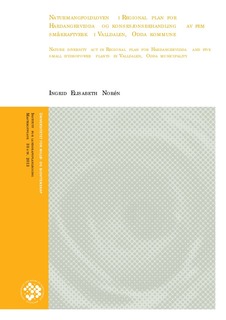Naturmangfoldloven i Regional plan for Hardangervidda og konsesjonsbehandling av fem småkraftverk i Valldalen, Odda kommune
Master thesis
Permanent lenke
http://hdl.handle.net/11250/188536Utgivelsesdato
2013-09-06Metadata
Vis full innførselSamlinger
- Master's theses (ILP) [763]
Sammendrag
I denne masteroppgaven undersøker jeg på hvordan naturmangfoldloven er brukt i Regional plan for
Hardangervidda og gjennom konsesjonsbehandling av fem småkraftsøknader i Valldalen i Odda
kommune, som omfattes av den regionale planen. Jeg ser spesielt på §§ 8-10 om henholdsvis
kunnskapsgrunnlaget, føre-var-prinsippet og økosystemtilnærming og samlet belastning.
«Regional plan for Hardangervidda – fylkesdelplan 2011-2025» ble utarbeidet på bestilling fra
Miljøverndepartementet (2007a), som ønsket fylkesdelplaner med fastsetting av nasjonale
villreinområder. Planen ble utarbeidet ved samarbeid mellom Hordaland, Telemark og Buskerud
fylkeskommune, og ble vedtatt plan høsten 2011 av de reseptive fylkestingene. Småkraft AS søkte i
2011 konsesjon for fem småkraftverk i Valldalen, og søknadene ligger per mai 2013 til avgjørelse hos
Norges vassdrags- energidirektorat (NVE). Naturmangfoldloven trådte i kraft i 2009, hvilket var etter
at planarbeidet med den regionale planen for Hardangervidda var påbegynt, men før den ble vedtatt.
I dette case-studiet har jeg gjennomført semistrukturerte kvalitative forskningsintervju med sentrale
aktører i utarbeidelsen av Regional plan for Hardangervidda, og berørte aktører i
konsesjonsprosessen i Valldalen. Den regionale planen, samt høringsuttalelser fra
konsesjonsprosessen er analysert.
Resultatene viser at naturmangfoldloven trekkes inn i Regional plan for Hardangervidda primært
gjennom et tilleggsnotat med vurderinger etter naturmangfoldlovens §§ 8-12. Prinsippene er i tillegg
delvis innarbeidet i planen, men det poengteres i plandokumentet at det er naturlig at
naturmangfoldloven blir grundigere vurdert i den lokale planleggingen og ved rullering av den
regionale planen. At planen med tilleggsnotat ble vedtatt uten innsigelse fra Miljøverndepartementet
må sees på som et signal om at planen oppfylte saksbehandlingsreglene i naturmangfoldloven.
I høringsuttalelsene til konsesjonssøknadene trekkes prinsippene i §§ 8-10 eksplisitt inn av
Fylkesmannen i Hordaland, og i implisitt av en rekke andre høringsparter. Primært er det uttalelser
fra motstandere av småkraftutbyggingene som trekker inn elementer fra naturmangfoldloven i sin
argumentasjon. Høringsuttalelsene er et produkt av en medvirkningsprosess, og denne prosessen har
betydning for hvem som deltar og hvilke opplysninger som blir spilt inn til NVE, som skal fatte vedtak
om konsesjon skal gis eller ikke. Manglende kjennskap til naturmangfoldloven kan være en årsak til
at loven i liten grad trekkes direkte inn i uttalelsene. Til tross for opplæring i loven med
representanter fra både Fylkesmannen i Hordaland, Hordaland fylkeskommune og Odda kommune,
er det kun Fylkesmannen som viser direkte til naturmangfoldloven i sin uttalelse.
Det er ulik oppfatning om hva som fungerer som avbøtende tiltak, og tiltakene som foreslås kan
grovt deles inn i tiltak som er avbøtende for friluftsliv og tiltak som er avbøtende for naturmangfold.
Nasjonale mål og forventninger for fornybar energi står ofte i spenning med mål for naturmangfold
og landskapsbilde, men naturmangfoldloven kan potensielt redusere slike spenninger. In this paper I examine how the nature diversity act is used in the Regional plan for Hardangervidda
and through licensing of five small hydropower plants in Valldalen in Odda municipality. I look
specifically at §§ 8-10 considering knowledge, the precautionary principle and ecosystem approach
and cumulative environmental effects.
"Regional plan for Hardangervidda – county sub plan 2011-2025" was produced on order from the
Ministry of the Environment (2007), who wanted county sub-plans determining national wild
reindeer areas. The plan was developed through collaboration between Hordaland, Telemark and
Buskerud County Council, and was approved during the autumn 2011 of the receptive county
councils. In 2011 Småkraft AS applied for concession for five small hydropower plants in Valldalen,
and as of May 2013 the decision is still to be made by the Norwegian Water Resources and Energy
Directorate (NVE). The nature diversity act came into force in 2009, which was after the planning
process with the regional plan for Hardangervidda had begun, but before it was authorized.
In this case study, I conducted semi-structured qualitative interviews with key participants from the
preparation of the Regional plan for Hardangervidda, and participants in the licensing process in
Valldalen. The regional plan, as well as submissions from the licensing process is analyzed.
The results show that the nature diversity act is incorporated into the Regional plan for
Hardangervidda primarily through an additional note with an assessment of the principals of the
nature diversity act §§ 8-12. The principals are also partially incorporated in the plan, but the
planning document points out that it is natural that nature diversity act is thoroughly considered in
the local planning and the rollover of the regional plan. That the plan with the supplementary note
was adopted without objection from the Ministry of the Environment should be seen as a signal that
the plan met the procedural provisions of the nature diversity act.
In submissions to the license applications, the principles of §§ 8-10 is explicitly expressed by the
County Governor of Hordaland, and implicitly by a number of others. It is primarily the statements by
opponents of small hydropower plants that include elements from the nature diversity act in its
reasoning. These submissions are products of a participatory process, and this process is important
for whom that participates and for what information NVE receives. NVE will decide whether to grant
a license or not. Lack of knowledge about the nature diversity act may be one reason why the law is
seldom drawn directly into the submissions. Despite the fact that representatives from the County
Governor of Hordaland, Hordaland County Council and Odda municipality have be educated in the
act, only the County Governor refers directly to nature diversity act in his submission.
There are differing opinions about what works as mitigation measures, and measures proposed can
be divided into measures for mitigating outdoor activities and measures for mitigating biodiversity.
National goals and expectations for renewable energy are often in tension with the goal of
biodiversity and landscape esthetics.
